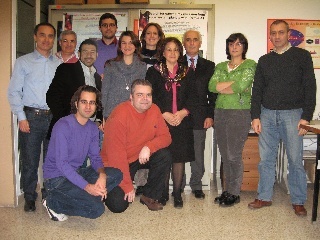The Bari group (INFN, Politecnico and University of Bari), led by Prof. Paolo Spinelli, has been involved in the Glast/Fermi mission since 2000.
At the beginning, from 2000 until October 2005, the main effort was focused on the tracker construction, assembly and test. In particular, the group was involved in the definition of plans and procedures and in the performance of all the environmental tests (dynamic and thermal) on trays and towers of the LAT silicon tracker (F. Giordano, M.N. Mazziotta, S. Rainò, P. Spinelli). We were also involved in the testing and qualification of the silicon sensors of the Fermi-LAT tracker (F. Gargano). Then, in 2006, we were involved in the beam test campaign both at CERN and GSI.
In the context of the software activities, during the same years, we also contributed to the ToT simulation code in G4 and to the effort before launch on the I&T studies on cosmic ray data on ground (M. Brigida, N. Giglietto, F. Loparco).
During the launch our group contributed to the LEO phase with the participation of 9 people.
After launch we focused on data analysis and our group followed several directions in the Science working groups and in the training of younger PHD and students (C. Favuzzi, P. Fusco, N. Giglietto, M.N. Mazziotta and P. Spinelli).
The most relevant contributions of our group are:
- Anisotropies searches with cosmic rays (M.N. Mazziotta, F. Loparco, N. Giglietto);
- Sun and Moon emission: the gamma-ray emission from the Moon and quiet Sun has been soon detected during the LEO and confirmed by Fermi in the first 18 months of the mission. For the first time the two emission (disk and IC) components from the Sun were separately detected and the spectra measured. The two sources will be carefully monitored by our group during the entire 24th solar cycle (M. Brigida, N. Giglietto);
- SNRs: are among possible sites where cosmic ray acceleration may take place. The main role of Bari group in this field is in the reconstruction of the spectra of these sources and also in the detection of the possible extension of the emission, that is essential in understanding where the emission is produced (i.e. from a compact object within the SNR, the shocked material, the shell) and at the same time crucial to reduce the galactic background (F. Giordano, N.Giglietto);
- Pulsar: we have worked mostly on the pulsar already detected by EGRET (Crab, Geminga, …) and performed detailed spectral analysis both phase averaged and phase resolved (F. Gargano and A. Caliandro now in Barcellona University);
- GRB: on this matter are involved several people (F. De Palma, C. Favuzzi, P. Fusco, P. Spinelli); we are involved mainly in the first detection and analysis of LAT bursts (as a BA) and in the spectral analysis of some peculiar events (F. De Palma); in this context F. De Palma is preparing his PHD thesis;
- AGNs: we are mostly involved in the study of spectral energy distribution of blazars (i.e. SED paper, Fermi-Planck MoU), using both standard analysis tools (gtlike) and the unfolding code. Moreover, we are involved in the analysis of the EBL, in the study of the characteristics of the Intermediate Synchrotron Peaked blazars as well as in the study of single blazar sources (C. Monte, S. Rainò, M.N. Mazziotta, F. Loparco, F. Gargano, F. Giordano);
- Dark Matter searches: several analyses for the dark matter search using both gamma-ray and cosmic-ray electron data are ongoing. A possible dark matter signal could be the detection of an excess of high energy cosmic ray electrons and positrons from the Sun due to a direct annihilation process of dark matter particles orbiting around the Sun or by the decay of intermediate particles produced after the annihilation of dark matter particles in the core of the Sun. Another possible dark matter signal could show up as an excess of gamma-rays from the galactic halo or from dark matter clumps located in some given sky position. (M.N. Mazziotta, F. Loparco, N. Giglietto, P. Fusco)
Concerning the tools and software for the analysis we are involved in the following codes:
- solar system software tools (N. Giglietto): tools to compute solar system body coordinates using the astro library and to perform the analysis in body-centered coordinates;
- SED tool (F. Gargano): tools to handle and produce SEDs;
- unfolding tools (M.N. Mazziotta and F. Loparco): tools to allow the reconstruction of the gamma-ray energy spectra from point sources without assuming an a priori model and using an iterative procedure based on the Bayes’ theorem. This analysis approach has been successfully implemented in the study of the energy spectra of several gamma-ray point sources (Sun, Moon, pulsars and AGNs).
- Extended sources studies with the Fermi Science tool gtlike, verified with simulations and SNRs (F. Giordano).
All of us have contributed to the success of these topics and we will continue looking forward to the new view of the Universe through the eyes of Fermi.
